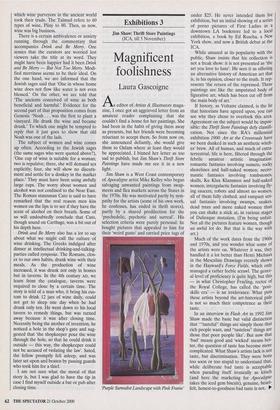Exhibitions 3
Magnificent foolishness
Laura Gascoigne
Aeditor of Artists & Illustrators maga- zine, I once got an aggrieved letter from an amateur reader complaining that she couldn't find a home for her paintings. She had been in the habit of giving them away as presents, but her friends were becoming reluctant to accept them. So from now on, she announced defiantly, she would give them to Oxfam where at least they would be appreciated. I binned her letter as too sad to publish, but Jim Shaw's Thrift Store Paintings have made me see it in a new light.
Jim Shaw is a West Coast contemporary of Apocalypse artist Mike Kelley who began salvaging unwanted paintings from swap- meets and flea markets across the States in the 1970s. He was motivated partly by sym- pathy for the artists (some of his own work, he confesses, has ended in thrift stores), partly by a shared predilection for the `psychedelic, psychotic and surreal'. His selection criteria were purely personal: he bought pictures that appealed to him for their 'weird gusto' and carried price tags of Purple Surrealist Landscape with Pink Frame' under $25. He never intended them for exhibition, but an initial showing of a series of porno pictures of First Ladies in a downtown LA bookstore led to a local exhibition, a book by Ed Ruscha, a New York show, and now a British debut at the ICA.
While amazed at its popularity with the public, Shaw insists that his collection is not a freak show: it is not presented as 'the art you love to hate'. He sees it as offering an alternative history of American art that is, in his opinion, closer to the truth. It rep- resents 'the return of the repressed. These paintings are like the amputated body of figurative art, which has been cut off from the main body of art.'
If history, as Voltaire claimed, is the lie that historians have agreed upon, you can see why they chose to overlook this area. Agreement on the subject would be impos- sible: the Thrift Store Paintings defy classifi- cation. Not since the RA's millennial exhibition 1900: Art at the Crossroads have we been dunked in such an aesthetic witch- es' brew. All of human, and much of extra- terrestrial, life is here, filtered through the febrile amateur artistic imagination: romantic fantasies involving sunsets, rocky shorelines and half-naked women; necro- mantic fantasies involving tombstones, skulls, Ku Klux Klansmen and half-naked women; intergalactic fantasies involving fly- ing saucers, robots and almost no women, all of them fully clothed; and rampant sex- ual fantasies involving swamps, snakes, dead trees and more naked women than you can shake a stick at, in various stages of Daliesque mutation. (I'm being unfair. Not all the pictures feature women, though an awful lot do. But that is the way with art.) Much of the work dates from the 1960s and 1970s, and you wonder what some of the artists were on. Whatever it was, they handled it a lot better than Henri Michaux in the Mescaline Drawings recently shown in the Hayward's Force Fields, which only managed a rather feeble scrawl. The gener- al level of proficiency is quite high, but this — in what Christopher Frayling, rector of the Royal College, has called the 'post- skills era' — is an irrelevance. What puts these artists beyond the art-historical pale is not so much their competence as their taste.
In an interview in Flash Art in 1992 Jim Shaw made the basic but valid distinction that ' "tasteful" things are simply those that rich people want, and "tasteless" things are those that poor people like'. But now that `bad' means good and 'wicked' means bet- ter, the question of taste has become more complicated. What Shaw's artists lack is not taste, but discrimination. They were born too soon or too stupid to understand that, while deliberate bad taste is acceptable when parading itself ironically as kitsch (and here the marketing for Apocalypse takes the iced gem biscuit), genuine, heart- felt, honest-to-goodness bad taste is not. 111" Oscar Wilde's observation in The Critic as Artist that 'a little sincerity is a danger- ous thing, and a great deal of it is absolute- ly fatal' has never been truer than it is today. In the Post-Modern art game, you get minus points for trying. What makes us squirm about this exhibition is its indecent public exposure of private obsessions, with- out the warrant of a socio-political subtext or the accreditation of psychotic Outsider status. These paintings are more embar- rassing for us to look at than Tracey Emin stuffing cash up her fanny. Yet there is something about the courage of the artists' convictions and their willingness to become fools for art — their 'magnificent foolish- ness', to borrow Wogan's immortal phrase from the Eurovision Song Contest — that gives them a genuine claim to the title of artist. This show brings home the beauty and horror, and absurdity, of the human condition more forcibly than the one at the Royal Academy. If you want your apoca- lypse now, here's where to find it.


























































































 Previous page
Previous page